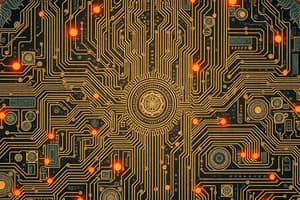Podcast
Questions and Answers
What happens to the light in a circuit when the current stops flowing?
What happens to the light in a circuit when the current stops flowing?
- It changes color
- It flickers
- It turns off (correct)
- It becomes brighter
Which component is responsible for storing magnetic energy in an electromagnetic field?
Which component is responsible for storing magnetic energy in an electromagnetic field?
- Capacitor
- Diode
- Resistor
- Inductor (correct)
What is the function of a diode in an electronic circuit?
What is the function of a diode in an electronic circuit?
- Allowing current in one direction only (correct)
- Storing electrical charges
- Regulating current flow
- Transforming electrical energy
Which component is used to regulate or reduce the amount of current passing through a circuit?
Which component is used to regulate or reduce the amount of current passing through a circuit?
What is the main role of a transformer in an electronic circuit?
What is the main role of a transformer in an electronic circuit?
Why are circuits considered essential for modern technology?
Why are circuits considered essential for modern technology?
What is a circuit?
What is a circuit?
Which component is essential in a circuit to control the flow of electricity?
Which component is essential in a circuit to control the flow of electricity?
In a basic light bulb setup, what does the filament inside the bulb do?
In a basic light bulb setup, what does the filament inside the bulb do?
What is the purpose of a resistor in a circuit?
What is the purpose of a resistor in a circuit?
Which element is NOT typically found in a basic circuit?
Which element is NOT typically found in a basic circuit?
What role does a capacitor play in a circuit?
What role does a capacitor play in a circuit?
Study Notes
Electronics Overview: Understanding Circuits
Electronics is a vast field encompassing various technologies and applications of electrical devices. At its core, electronics revolves around the study and application of electric currents, voltages, and the behavior of electrons within devices designed with the purpose of transmitting information or performing specific tasks. One of the fundamental aspects of this field is understanding how electronic components work together in an arrangement known as a circuit.
What Is a Circuit?
A circuit is defined as a closed path along which an electric current can flow between two points or through one or more electric conductors. In simpler terms, it's like building roads for electricity. These paths consist of different types of wires, resistances, switches, capacitors, and other elements, all interconnected in such a way that they allow an electric charge to be transferred from one point to another in a controlled manner.
How Does a Typical Circuit Work?
To understand how a typical circuit works, let's consider a simple example - a basic light bulb set up. This setup includes a power source (like a battery), a switch to control the power, and a filament inside the light bulb that glows when powered by electricity. When you turn the switch on, it connects the circuit, allowing the power from the battery to travel through the wire and reach the filament in the bulb. As soon as the filament receives enough energy, it starts heating up and emits visible light because of high temperature and gas pressure. Once the circuit is broken (by turning off the switch) or there is a fault in any part of the circuit, the current stops flowing, and the light turns off.
Components of a Circuit
In an electronic circuit, several key components play important roles in controlling, regulating, and directing the flow of electrical current. Some common examples include:
- Resistor: A device used to regulate or reduce the amount of current passing through a circuit.
- Capacitor: An electrostatic energy storage component that can store electrical charges momentarily.
- Inductor: A passive two-terminal electrical component that stores magnetic energy in an electromagnetic field.
- Diode: An electronic component that allows current to pass in only one direction while blocking it in the opposite direction.
- Transformer: An electrical device that transfers electrical energy from one coil to another through induction without physical contact.
These are just a few examples among many others found in complex circuits. Each type of component serves a particular function, making them essential for creating various functions within electronic systems.
Applications of Circuits
Circuitry forms the backbone of countless technological advancements we see today. From smartphones to computer processors, from home appliances to industrial machinery, almost every electronic gadget relies heavily on well-designed circuits. Even seemingly ordinary items such as traffic lights and sensors contain these intricate networks of connected parts managing their operations. Without circuits, most modern technology would be unable to operate effectively.
Conclusion
Understanding the basics of circuits provides a solid foundation for delving deeper into the world of electronics. It explains why some materials conduct better than others, what makes certain components so versatile, and even hints at the potential for future innovations. With continued interest, curiosity, and experimentation, tomorrow may bring new breakthroughs in electronics technology driven by our knowledge of these fundamental principles.
Studying That Suits You
Use AI to generate personalized quizzes and flashcards to suit your learning preferences.
Description
Test your knowledge on the fundamental concepts of electronic circuits, including components, circuit functionality, and applications in various technological devices. Explore how circuits work, the roles of components like resistors and capacitors, and the significance of circuits in modern technology.




